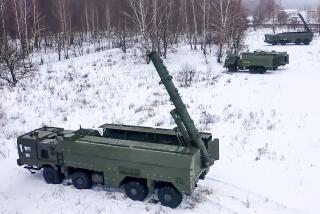U.S. Speeds Review of Nuclear-War Plan : Military: Reacting to Soviet changes, the Pentagon weighs eliminating targets and cutting the arsenal.
- Share via
WASHINGTON — Striving to keep pace with the Soviet transformation, the Bush Administration has stepped up a review of its nuclear-war plan and hopes in months to decide which military sites can be eliminated as targets for a U.S. nuclear strike and how deeply the U.S. nuclear arsenal can be reduced, sources have told The Times.
The accelerated review is part of a process initiated two years ago by Defense Secretary Dick Cheney. The process was escalated after the unsuccessful Soviet coup in August and the emergence of Baltic republics as independent states, officials said.
The new findings, expected in January, could allow the United States to go “above and beyond” the nuclear-arms reductions that President Bush announced last week by making deeper cuts in the U.S. nuclear arsenal, they added.
Officials said the exercise is testing some of the U.S. nuclear strategists’ most fundamental assumptions about thermonuclear war in an age of democratization of the Soviet republics.
Cheney, confirming the review process, said in an interview Wednesday that the Pentagon’s reassessment of U.S. nuclear targets already has “resulted in some new thinking with respect to what our requirements are.”
“Suffice it to say it’s a much more effective (nuclear war plan) than we had previously, and it has been modified to reflect the changes that are occurring in the world,” he said.
The revised Single Integrated Operational Plan that emerges from the process will be reflected in the Pentagon’s 1994 budget request and the six-year defense plan that flows from it, said a knowledgeable official.
The review is being conducted largely under Cheney’s direction by Pentagon civilians--long excluded from reviewing nuclear plans--and the uniformed nuclear specialists of the Joint Staff.
In their task, the Pentagon reviewers have worked closely with Gen. Lee Butler, commander of the Strategic Air Command and director of the Joint Strategic Targeting Planning Staff, which helps keep the U.S. nuclear-war plan up to date and in line with presidential directives.
Cheney described the review that he launched in 1989 as “a more fundamental review” than that conducted by Butler’s staff alone. “We are adapting our basic war plan to the changing realities in the world,” said Cheney, who added that further reductions in the nuclear arsenal are likely to result.
In April, The Times reported that as many as 20% of the 8,500 targets in the now-defunct Soviet Bloc had been deleted from the U.S. nuclear-war plan as a result of a two-year review completed last spring. The review now nearing completion, which draws from the Cheney-led process and the annual planning staff review process, is said to have proceeded where that assessment left off.
Officials said the pace of changes in the Soviet Union, as well as changes in the U.S. arsenal proposed by Bush, have posed new challenges for Pentagon officials charged with choosing nuclear targets. They also have presented new opportunities for reductions in the U.S. nuclear arsenal, the officials said.
Changes in the Soviet military and society are likely overall to reduce targets for U.S. warheads, officials said. But at the same time, they said Bush’s initiatives, which take many U.S. strategic weapons off alert, in some scenarios would make fewer U.S. warheads available to launch a retaliatory strike against the Soviet Union.
The newly independent Baltic states, for instance, have long been dense with potential nuclear targets. That is because military installations maintained there were key to the Soviet Union’s strategic air defenses, as well as to the Soviets’ ability to make war on Western Europe with conventional and short-range nuclear weapons. As those forces are withdrawn from the Baltics and moved to Soviet military facilities, many nuclear targets are likely to be consolidated, experts said.
Since early September, the Soviet military also has been moving long-range missiles from sites in Kazakhstan and the Ukraine and taking them to missile fields in the Russian Federation. Such consolidations also are expected to bring greater efficiency to the U.S. targeting plan.
“When you take ICBMs (intercontinental ballistic missiles) out of the forces and destroy missiles and silos, part of the target base goes away,” Cheney said Wednesday. “When there are changes in Eastern Europe such as we’ve seen in the past few years, part of the target base goes away.”
Officials added that, if the Soviets respond to Bush’s initiatives in ways that the Administration hopes, even greater reductions may be possible in the list of targets and the weapons needed to threaten them, officials said.
For instance, if the Soviets remove and destroy their inventory of short-range nuclear weapons, based at sites in nearly every Soviet republic, one knowledgeable source said that hundreds of targets could disappear from the targeting list.
Dramatic changes in Soviet society also have challenged long-held assumptions about the definition of potential nuclear targets, officials said. Although U.S. nuclear strategists have traditionally planned to attack Soviet “leadership” posts with nuclear targets, an official conceded that such concepts have begun to lose their meaning in a society where Communist Party leaders no longer exist and republic leaders have proliferated.
“We’re still sifting through the evidence to see what the command structure (of the Soviet Union) is, so we’re not really sure what would be targeted,” said one official involved in the review. “And all of this is happening as we are trying to complete the review.”
More to Read
Sign up for Essential California
The most important California stories and recommendations in your inbox every morning.
You may occasionally receive promotional content from the Los Angeles Times.













